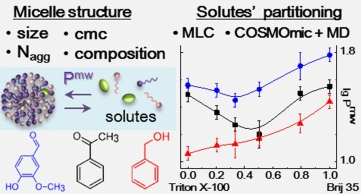A.S. Konevaa, E. Ritter, Y.A. Anufrikova, A.A. Lezova, A.O. Klestovaa, N.A. Smirnova, E.A. Safonova, I. Smirnova
“Mixed aqueous solutions of nonionic surfactants Brij 35/Triton X-100: Micellar properties, solutes’ partitioning from micellar liquid chromatography and modelling with COSMOmic”
Colloids and Surfaces A, 2018, 538, 45–55.
DOI: 10.1016/j.colsurfa.2017.10.044
Aqueous solutions of nonionic surfactants are of interest for bioprocesses, particularly as solubilizing agents for hydrophobic substances. To design such processes, the data on partition coefficients of solutes between micelles and their aqueous surrounding (Pmw) are of high value. An extended understanding of the partition behavior can be achieved from the structural information such as the micelle size and micelles composition.
In this work, mixtures of nonionic surfactants Triton X-100 and Brij 35 were under study. The data on critical micelle concentrations showed partly non-ideal behavior of the solutions. The compositions of mixed micelles at different molar Brij 35/Triton X-100 ratios in the surfactant mixture were estimated from the data on selfdiffusion coefficients (NMR diffusometry) and were calculated within the regular solution approach and predicted by Motomura’s model. The change of the mixed micelle composition in dependence on the total surfactant concentration was observed. It has been found, that the average value of the mixed micelles radii is∼4 nm. Whereas, the polydispersity indexes and the aggregation numbers increased with Triton X-100 fraction. Moreover, the Pmw values of different non-dissociated solutes (phenyl derivatives with various functional groups) were determined by means of micellar liquid chromatography (MLC) and were predicted using the thermodynamic model COSMOmic, an extension of COSMO-RS. In general, it has been proved that COSMOmic is able to predict Pmw in the mixed micellar system formed by nonionic surfactants. The obtained data show the possibility of modulating the partition behavior of solutes using the mixtures of nonionic surfactants. Apart from the hydrophobicity, the «surfactants – solute» specific interactions play an important role in the partition behavior of the investigated systems.
